
The Oldest Extant House in La Crosse
(written by Dr. Les Crocker, UWL Emeritus Professor of Art History)
This topic is covered in much more detail in my forthcoming book Immigrants All. Contact the Archives Department at La Crosse Public Library to reserve a copy.

A drawing of the Nathan Myrick cabin at State and Front streets where the Charmant now stands
Which is the oldest surviving house in La Crosse?
I get this question quite often, I guess it is part of our culture’s concern over first, last, biggest, smallest, fastest, tallest, the extremes that seem to fascinate people. My answer usually disappoints them, because I don't know which house in La Crosse is the oldest.
A title such as “Oldest Existing House in La Crosse” isn’t very meaningful since such survival would be completely accidental. The first three blocks east of the Mississippi River, the core of the town in the 1840s and 1850s, were constantly changing in the early years as the town grew. Buildings burned down, were torn down, were enlarged or rebuilt, and were moved to new locations. Nobody kept track of these changes; there was more important stuff to do.
Research material for these early years is understandably limited. Since La Crosse was chartered as a city in 1856, property tax records for the town do not exist prior to 1857 and they do not separate real estate value from capital improvements upon that land until 1885. As a result, reports in the newspapers are the most common record of early buildings. But it is often difficult to connect the newspaper account with actual buildings in their original location so this method will produce little definite information until large numbers of lots can be connected to the owners and what they built. The quite accurate birds eye view maps, from 1867, 1876 and 1887 show the general size and shape of structures, providing limited information. All things considered we have a very limited view of who built what in La Crosse prior to 1857. Outdoor photography came to La Crosse in the early 1870s as it was an expensive and difficult task at that time. Even then, labels were scant, such as “Dr. MacArthur’s House.” Not very helpful.
And don’t get me started on the city directories! The directories, which start in 1866, are not very helpful either until the Philadelphia post office standard style of assigning addresses finally was adopted in La Crosse. An example from 1866: “e s Front bet Main and State” which means east side of Front Street between Main and State streets. Here’s another good one from 1873: “r 45 S Fifth” which means residence is the 45th building/house on South Fifth. Gosh, there were houses being built on empty lots in between each year!
The late 1840s and all of the 1850s were chaotic in the new town. In 1845 there were 17 people living near the river bank in the area now bounded by the La Crosse River and Cass Street. Nine years later, in 1854, the Reverend Spencer Carr, trying to attract newcomers to settle in La Crosse, compiled a list of 745 white people in the community as indigenous peoples were excluded. The 1855 census showed 1,637 citizens in La Crosse; the town had more than doubled in population in two years. New streets, new houses, new schools, wells dug, outhouses built, chicken houses, pig pens, shelter for the cows, probably some goats as well. The immigrants were pouring in; they needed schools, fire protection, police protection, lawyers, and honest government workers.
They also needed cast-iron stoves, coal, cooking gear and table ware, bed frames and mattresses, soap, clothes, lamps, furniture. Those who came by wagon brought a few precious items but most who came by river carried everything they owned in their hands or on their back. In short, they needed everything, and housing was the first priority.

The busy La Crosse riverfront levee where goods and people embarked and disembarked
At last, we arrived in La Crosse and were duly installed in Castle Garden, a place built to keep immigrants until their friends came for them. It was probably the size of a city block, with a high board fence on three sides and the Mississippi River on the fourth side. Inside of this fence was a large shed divided into stalls and having a shanty roof. Each stall was boarded up on three sides, the fourth side being open. Each immigrant family was installed in a compartment and allowed to stay there until friends came for them or until they could make arrangements to leave. Lights burned all night and the police were on hand both day and night.
No tramps, salesmen or slickers were in there. The immigrants were expected to furnish their own food and bedding, but were allowed to stay in their quarters as long as they wished.”
excerpt from “An Immigrant’s Memories” La Crosse County Historical Sketches # 7 p79
Obviously, there was a great need for housing.
Without the steam engine, large migrations would have been very different in the United States for two reasons. They powered the large boats and later the railroad engines that carried the immigrants to distant places. Secondly, they powered the saw mills that produced huge quantities of inexpensive lumber of standard sizes. The balloon frame system of construction, the predecessor of our stud and deck system, allowed the rapid construction of basic houses by people with little training in construction. For many years, almost any man who could swing a hammer could find a job in La Crosse.
After whites invaded this area, the first residence we have on record is the log cabin built by Nathan Myrick in 1841 but that building did not survive long and it was not a “house” as we think of them. It was a rudimentary trading post with quarters for the family.
Our first significant record of early housing is in the newspaper clipping file for the Mons Anderson house at the public library archives. The undated newspaper article discusses houses built in the 1850s that had since been moved to other locations. Harry J. Hirshheimer was a significant local historian, and he used the 1856 map of La Crosse to figure out where many of these buildings had been relocated.
Based on Hirshheimer’s conjecture, I propose the following houses as contenders for the title of oldest.
Mons Anderson House, 410 Cass Street, west section
Built: 1854
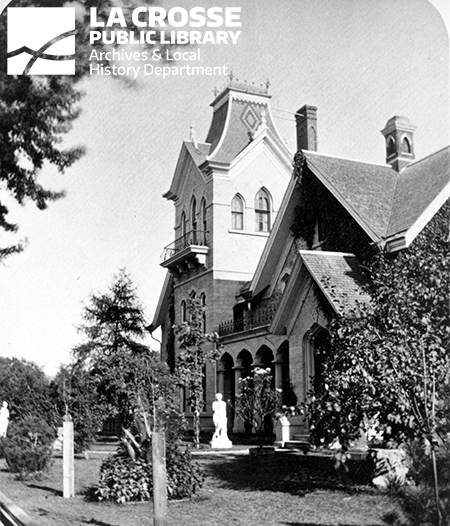
Historic image of the Mons Anderson House dates from roughly 1881
Andrew Shepard built a two-story stone house at what would become 4th and Cass streets in 1854. On the edge of the town, it was the earliest stone house and one of the few stone houses ever built in La Crosse. Although some immigrants from Europe had a strong bias for stone, the local stone from Grandad Bluff is not very good for building having numerous crystal formations and voids. Less expensive, standard-sized lumber was being produced by the numerous local saw mills and became the building material of choice in La Crosse over stone.
The original house is the part to the right of the tower excluding the entry vestibule, the four arches and the library now at the rear. The more irregular sized stones and wider mortar joints indicate its early age. In 1864 Mons Anderson bought the house and in 1878 enlarged it to the present appearance.
George and Christina Scharpf House, 524 Main, later 1223 S 5th Street
Built: 1854-55
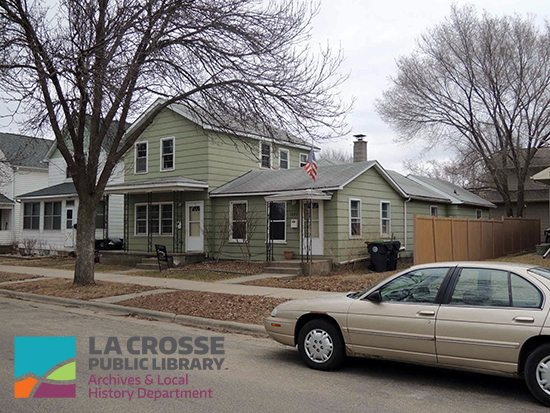
Image of the Goerge and Christian Scharpf House taken by the Author, 2014
This simple rectangular house was built at 524 Main street and the Scharpfs lived there until George’s death in 1904. The house was then used for commercial purposes until it was moved to Fifth Avenue at the time of the construction of the Majestic Theater building about 1910.
It was built as a 1 3/4 story house; the kitchen ell at a right angle to the main house, was a later addition, as was the addition behind the kitchen. Originally the house would have had no decoration, although Scharpf may have added some Italianate details in later years. It probably had a one-bay porch at the entrance or even just an entrance roof.
Sherwin-Rodolf House 1728 Market Street originally at 5th & State SW until 1890s
Built: ca. 1855
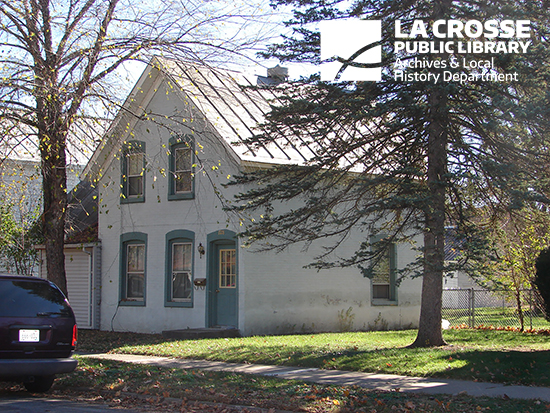
Image of the Sherwin-Rodolf House taken by the Author, 2012
The Reverend John C. Sherwin and his wife Virginia A. were in La Crosse in 1852-1857 and for a few years he was an important figure in the early stages of the community’s development and life. This house was built on the southwest corner of 5th and State streets, and after Sherwin’s departure from La Crosse, it was bought by Theodore Rodolf, another old settler, who lived there until his death in 1892. Several years later the house was moved to its present location and veneered with brick. By the time of Rodolf’s death in 1892, the commercial district had spread east and surrounded his house, and it was soon moved to its present location.
Renwick Howard House, 318 S 8th Street
Built: ca. 1855
First George Howard House, 320 S 8th Street
Built: ca. 1855 (left house in image)
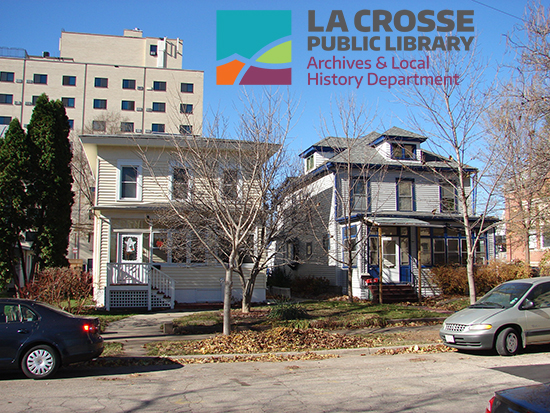
Image of Howard Houses taken by the Author, 2012
Hiding in plain sight on South 8th Street are two of the earliest houses remaining in La Crosse. They are unnoticed because they are disguised as four-square houses from the about 1915. Built by brothers, Renwick and George Howard, these houses were on the east side of 3rd Street, near Jay street according to local historian Harry Hirshheimer. There are several other instances of brothers building twin, or almost twin, houses in La Crosse. They were built before 1855 but how much before is unknown at this time.
Three-bays wide and two-stories high, these were large houses for their time. The enclosed front porch and the dormer window in the attic are later additions, probably from 1915 when they were moved. The rear addition is older than the porch and dormer, it was probably added when the houses were moved.
John Hartung House, 930 Adams Street
Built: before 1856
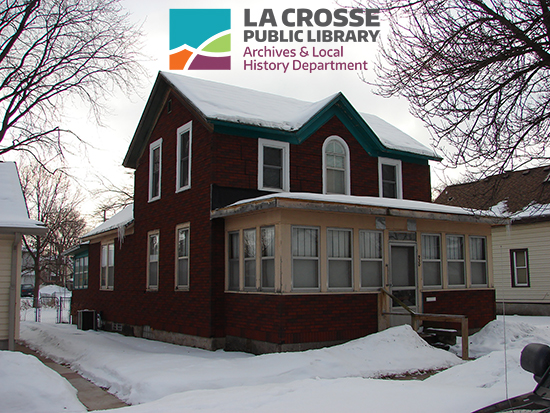
Image of the Hartung House taken by the Author, 2011
This house was moved to Adams Street about 1914 from an unknown location. John Hartung was the first owner at this location. The arched window beneath the gable would have been above the entrance to create more emphasis on the center of the house. Even though the original front porch has been enclosed and the house resided the overall design of the house and the single arched window in the center bay of the second story shows the age of this house.
Randall-Shorna House, 225 Avon Street originally located at 321 N 6th Street
Built: 1856
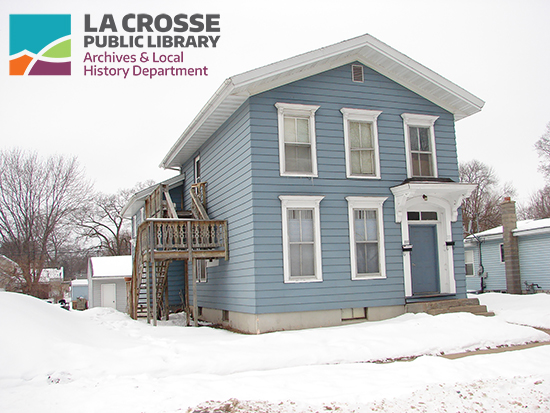
Image of the Randall-Shorna House taken by the Author, 2011
The brackets supporting the entrance roof and similar brackets supporting the cornices of the windows suggest a date in the 1860s or 1870s but the shape of the house and the public records indicate otherwise. The Shorna house was originally at 321 N. 6th and built for James M. Randall in 1856.
The three-bay front is typical for early Italianate houses in La Crosse, although this house is narrower than the brick versions that dominate in the 1870s and 1880s. The simple window heads and entrance hood are typical of the time, more elaborate brackets, window and door trim became common after the Civil War. If original, and I don't think it is, the three-sided bay window is one of the earliest in La Crosse.
An older section of the house is at the rear, offset from the newer, taller, section in front, a physical reminder of how families increased their living space as they became more prosperous. The top light over the front door was used in the 1850s and 1860s but disappears in the 1870s.
Rublee-Washburn-Jenks House, 612 Ferry Street
Built: 1856, 1886
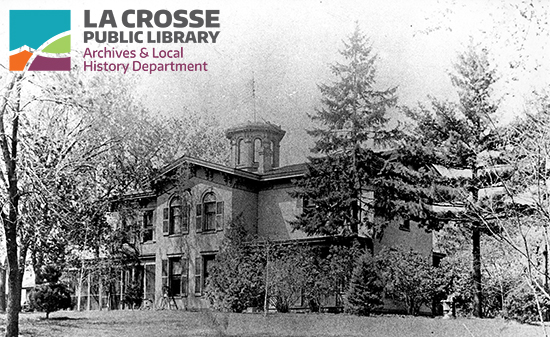
Historic photo of the Rublee-Washburn-Jenks House taken between 1886-1900 that includes the additions that Jenks built
Francis M. Rublee, a native of Vermont, came to the Wisconsin Territory in 1839 to La Crosse in 1851 when La Crosse County was formed from Crawford County. There were only five families at the La Crosse townsite at that time.
The year 1857 saw a major economic upset in the United States, and Rublee was caught holding land that had declined in value below the price he had paid. He headed west by himself to Pikes Peak, Colorado, in the spring of 1860 to remake his fortune, but died there in November. The house was purchased by Cadwallader C. Washburn in 1861 who was often away from the city and died in 1882. Calvin J. Jenks purchased it from Washburn’s estate in 1884, and added a second story to each wing and thus massively changed the design in 1886. Unfortunately, it needs a major restoration.
Tuteur House, 101 S 9th St
Built: 1856
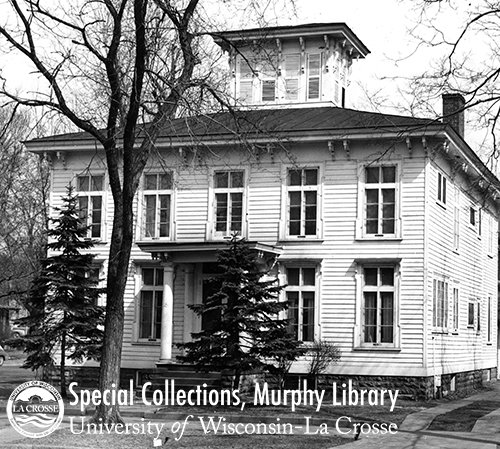
Image of the Isaac and Fannie Tuteur House courtesy of Special Collections, Murphy Library, UWL, taken 1948
This house, one of the oldest in the community, shows the earliest Italianate forms of brackets and the cupola. It was originally owned by Isaac and Fannie Tuteur, one of the early Jewish families in town who arrived in 1856.
So, that is my answer with possibilities. Not to mention the dozens of old houses that were enlarged into newer houses, made into back rooms, garages, or even chicken coops.
